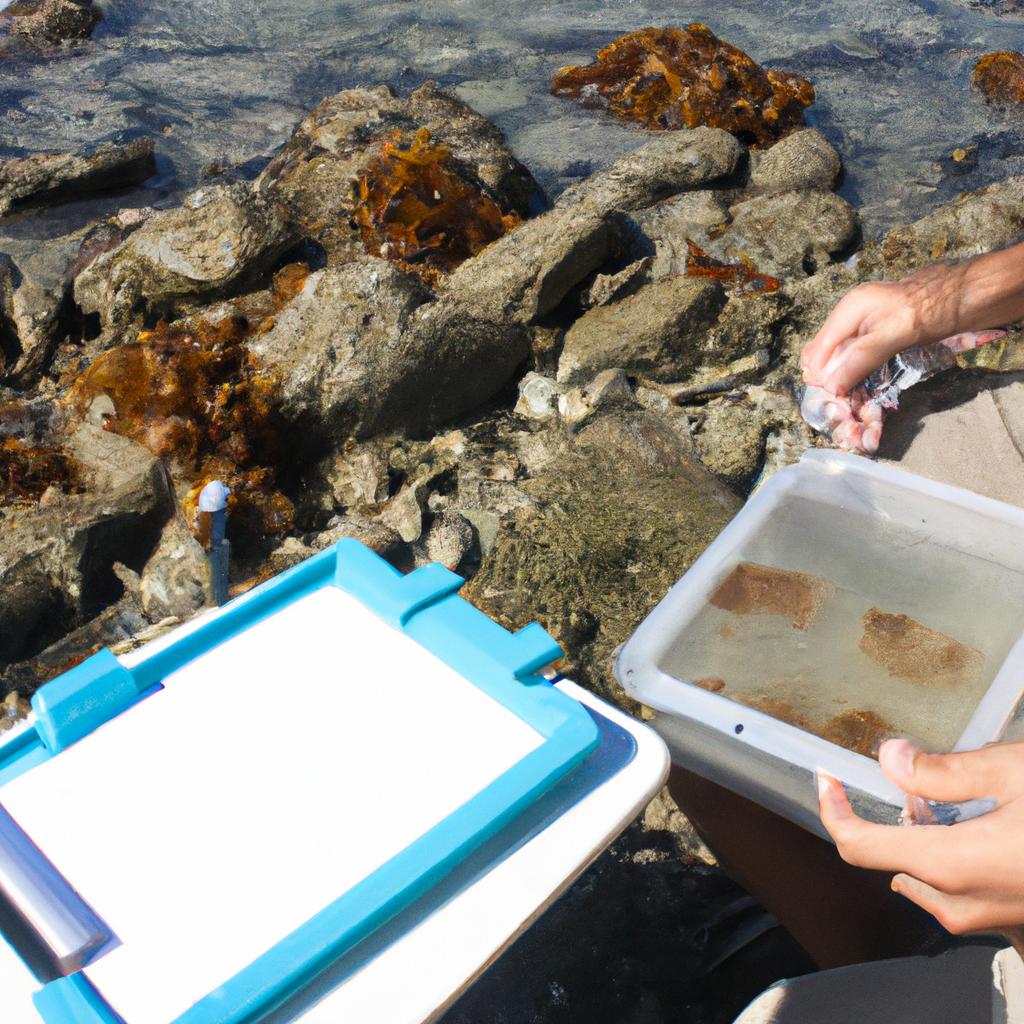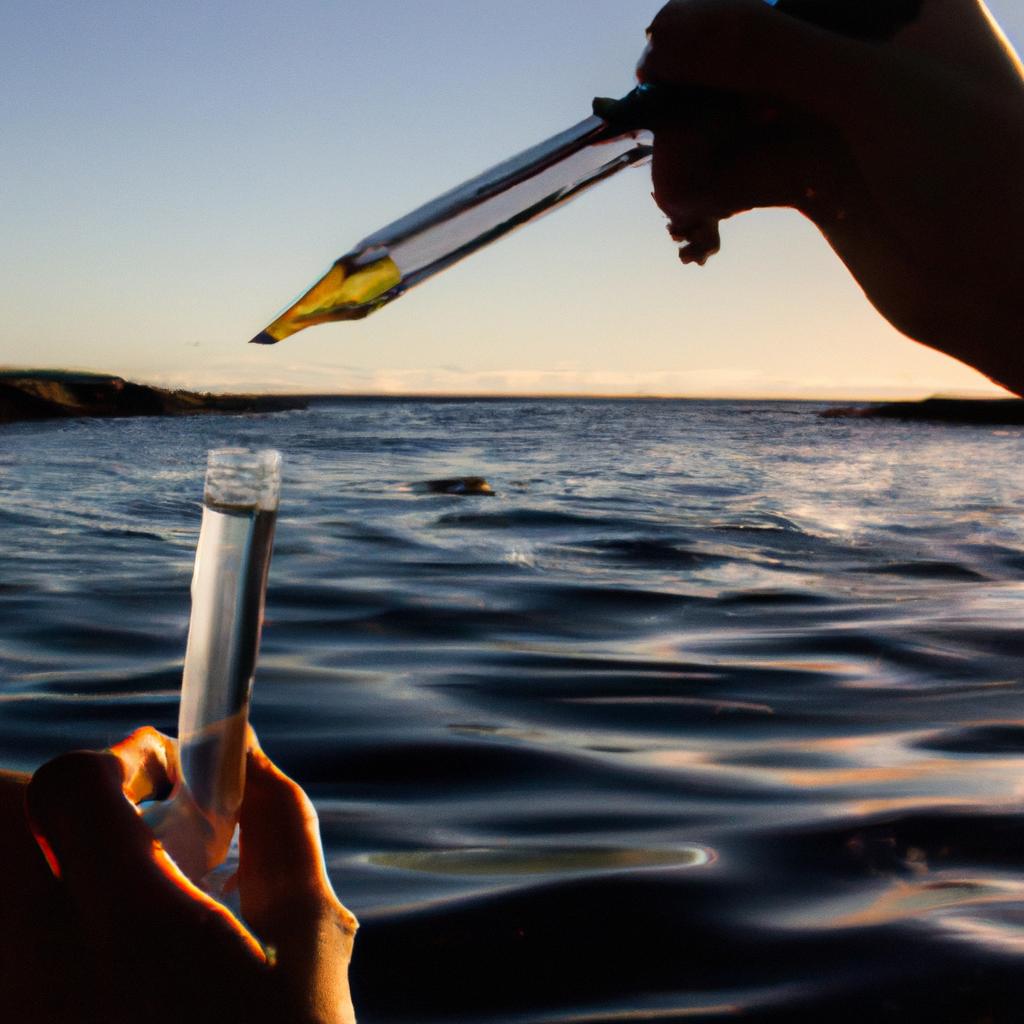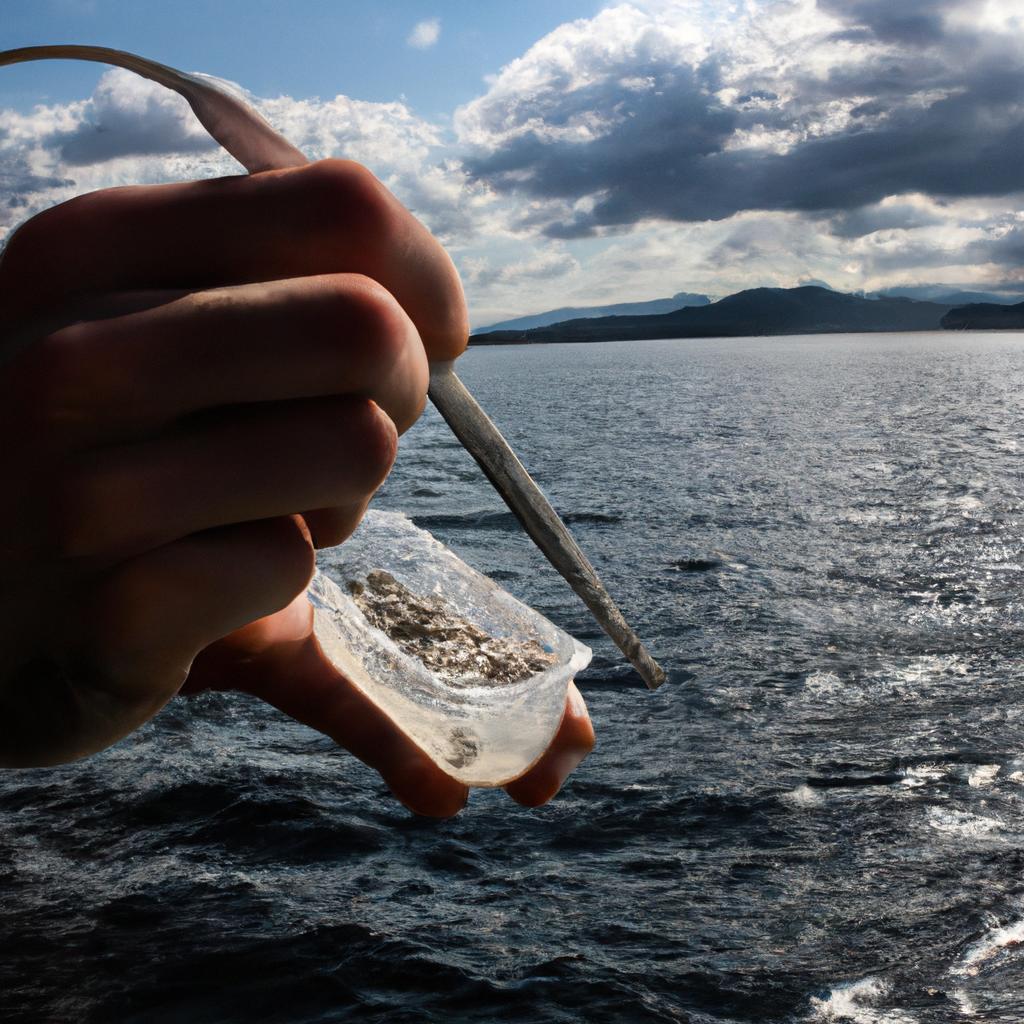Climate change and ocean acidification are two interconnected phenomena that have been causing significant impacts on marine ecosystems worldwide. The rising levels of greenhouse gases in the atmosphere, primarily carbon dioxide (CO2), lead to an increase in global temperatures, resulting in climate change. Additionally, excessive CO2 emissions are absorbed by the oceans, leading to a process known as ocean acidification. These environmental changes have far-reaching consequences for marine organisms and their habitats.
For instance, consider the case of coral reefs, which are highly susceptible to both climate change and ocean acidification. Rising sea temperatures due to climate change can cause coral bleaching events, where corals expel symbiotic algae living within their tissues, leading to their death and subsequent decline of reef health. Furthermore, increased acidity levels from ocean acidification inhibit the ability of corals and other calcifying organisms to build their calcium carbonate skeletons or shells properly. This double assault makes it challenging for these delicate ecosystems to recover from disturbances such as storms or pollution.
The combined effects of climate change and ocean acidification pose a threat not only to individual species but also entire food webs and biodiversity in marine environments. Understanding these impacts is crucial for devising effective conservation strategies aimed at mitigating further damage and preserving the integrity of our ocean ecosystems. These strategies may include reducing greenhouse gas emissions to minimize the effects of climate change, implementing sustainable fishing practices to protect vulnerable species, and establishing marine protected areas to safeguard critical habitats.
Additionally, efforts can be made to raise awareness about the importance of ocean conservation and promote sustainable behaviors among individuals and communities. Supporting scientific research and monitoring programs can also provide valuable insights into the ongoing changes in marine ecosystems and help inform decision-making processes.
Ultimately, addressing the interconnected challenges of climate change and ocean acidification requires a comprehensive approach that involves global cooperation, policy interventions, technological advancements, and individual actions. The preservation of our ocean ecosystems is not only crucial for the health and survival of marine life but also for the well-being of human societies that rely on these ecosystems for food security, livelihoods, tourism, and various other ecosystem services.
Rising sea temperatures and climate change: The increase in global temperatures is causing significant changes in marine ecosystems, including shifts in species distribution and altered reproductive cycles of marine organisms.
Marine ecosystems around the world are experiencing profound impacts as a result of rising sea temperatures and climate change. One example that highlights these effects is the case study conducted in the Great Barrier Reef, one of the most iconic coral reef systems on Earth. Research has shown that increased ocean temperatures have led to widespread bleaching events, where corals expel their symbiotic algae due to stress. This phenomenon has devastating effects on coral reefs and the diverse marine life they support.
The consequences of rising sea temperatures extend far beyond coral reefs. Changes in water temperature affect various aspects of marine ecosystems, contributing to shifts in species distribution patterns. As certain areas become warmer or cooler than before, some species may migrate towards more suitable habitats while others struggle to adapt. These alterations disrupt established ecological relationships within communities and can lead to imbalances in predator-prey dynamics or competition for resources among different species.
Moreover, climate change-induced increases in sea surface temperature also impact the reproductive cycles of many marine organisms. For instance, higher water temperatures have been observed to influence the timing and success rates of fish spawning events. In some cases, disrupted breeding seasons may result in decreased population sizes or reduced genetic diversity within affected species. These implications can have cascading effects throughout entire food webs and potentially compromise ecosystem resilience.
To evoke an emotional response from our audience regarding this issue:
- Rising sea temperatures threaten fragile ecosystems teeming with vibrant marine life.
- Coral reefs, often referred to as “rainforests of the sea,” face imminent destruction.
- Many iconic marine creatures beloved by people worldwide are at risk.
- Urgent action is required now to protect these invaluable underwater treasures.
Furthermore, it is essential to consider the broader implications of these changes on human societies reliant on healthy oceans for sustenance, economic activities, and cultural practices. The disruption of marine ecosystems through rising sea temperatures poses a significant threat to the livelihoods and well-being of coastal communities worldwide.
In light of these impacts, it is crucial to recognize that coral bleaching events and shifts in species distribution are not isolated incidents but rather symptomatic of broader changes occurring within our oceans. Understanding the underlying causes and effects of climate change on marine ecosystems allows us to develop effective strategies for mitigation and adaptation. In the subsequent section about “Coral bleaching and ocean warming,” we will explore how rising ocean temperatures specifically contribute to coral bleaching events and their devastating consequences for both reefs and associated marine life.
Coral bleaching and ocean warming: Rising ocean temperatures are leading to coral bleaching events, where corals expel the algae that provide them with food and color. This phenomenon has devastating effects on coral reefs and the diverse marine life they support.
Impact on Marine Ecosystems: Climate Change and Ocean Acidification
Rising sea temperatures and climate change have significant implications for marine ecosystems. This section will explore another consequence of these changes: ocean acidification. To illustrate the potential impacts, let us consider a hypothetical scenario in which carbon dioxide (CO2) emissions continue to rise at current rates.
One example of how ocean acidification affects marine life is its impact on shell-forming organisms such as oysters, clams, and corals. As CO2 dissolves into seawater, it reacts with water molecules to form carbonic acid. This process lowers the pH level of the water, making it more acidic. The increased acidity can inhibit the ability of these organisms to build their protective shells or skeletons, leading to weakened structures that are more susceptible to damage.
The consequences of ocean acidification are far-reaching and extend beyond just shell-forming organisms. Here are some key points illustrating its effects:
- Reduced biodiversity: Acidic waters can disrupt various ecological processes essential for maintaining species diversity.
- Altered food webs: Changes in pH levels can affect the availability of certain plankton species that form the base of many marine food chains.
- Decline in calcifying organisms: Ocean acidification threatens not only coral reefs but also other calcifying organisms like mollusks and echinoderms.
- Impacts on fisheries: Many commercially important fish species rely on healthy coral reefs and other affected habitats for shelter and food sources.
To further emphasize these impacts, consider this table showcasing the vulnerability of different marine organisms to ocean acidification:
| Organism | Vulnerability Level |
|---|---|
| Coral Reefs | High |
| Shellfish | Moderate |
| Plankton | Low |
| Fish Species | Variable |
As we assess the cumulative effects of rising sea temperatures, coral bleaching events, and now ocean acidification, it becomes evident that urgent action is needed to mitigate climate change and its consequences for marine ecosystems. The next section will delve into another critical issue: melting polar ice caps and sea level rise.
Melting polar ice caps and sea level rise: As global temperatures rise, polar ice caps are melting at an accelerated rate. This results in a rise in sea levels, threatening coastal habitats and causing habitat loss for many marine species.
Impact of Overfishing on Marine Ecosystems: Decline in Fish Stocks and Ecological Imbalances
The consequences of climate change on marine ecosystems extend beyond coral bleaching and sea level rise. Another significant issue is the impact of overfishing, which has been a growing concern for global fisheries. To illustrate this point, let’s consider a hypothetical scenario involving the decline of tuna populations due to excessive fishing practices.
Overfishing can have devastating effects on fish stocks and create ecological imbalances within marine ecosystems. This practice occurs when more fish are caught than can be naturally replenished, leading to a decline in population sizes and potential extinction threats for certain species. In our example, longlining techniques targeting tuna result in an unsustainable harvest that outpaces the ability of these fish to reproduce and replenish their numbers.
- Loss of biodiversity: The decline or disappearance of certain fish species disrupts the delicate balance within marine food webs, affecting predator-prey relationships and overall ecosystem health.
- Altered trophic cascades: Removal of top predators such as large predatory fish leads to increased populations of lower-level consumers, causing imbalances throughout the entire food chain.
- Increased vulnerability to disease outbreaks: Weakened populations due to overfishing become more susceptible to diseases, threatening both targeted species and other organisms dependent on them.
- Economic impacts: Overfishing not only depletes natural resources but also affects local economies reliant on fishing industries, resulting in job losses and reduced livelihoods for coastal communities.
To visualize these consequences further, here is a table showcasing some key environmental and socio-economic impacts caused by overfishing:
| Environmental Impacts | Socio-economic Impacts |
|---|---|
| Disrupted food chains | Job losses |
| Decline in biodiversity | Reduced income for fishermen |
| Ecosystem imbalances | Increased poverty in coastal areas |
| Threats to marine habitats | Impacted tourism industry |
In light of these alarming trends, it is crucial to address the issue of overfishing and implement sustainable fishing practices. This will require collaboration between governments, fisheries management organizations, scientists, and local communities to establish effective policies that promote responsible harvesting techniques and protect vulnerable fish populations.
Ocean acidification and its impact on marine life: Increased carbon dioxide levels in the atmosphere are being absorbed by the ocean, leading to ocean acidification. This acidification affects the ability of marine organisms to build their shells and skeletons, disrupting entire food chains.
Impact of Climate Change on Marine Ecosystems: Decline in Biodiversity
The consequences of climate change and ocean acidification extend beyond the melting polar ice caps and rising sea levels. The delicate balance of marine ecosystems is being disrupted, leading to a decline in biodiversity and threatening the survival of numerous species.
One example that highlights the impact of climate change on marine ecosystems is the bleaching events observed in coral reefs across the world. Corals rely on a symbiotic relationship with algae called zooxanthellae for their survival. However, as sea temperatures rise due to global warming, corals become stressed and expel these vital algae, resulting in widespread bleaching and eventual death. This phenomenon not only leads to the loss of vibrant coral reef habitats but also affects other organisms dependent on these reefs for food and shelter.
The far-reaching effects of climate change on marine ecosystems can be summarized as follows:
- Increased frequency and intensity of extreme weather events such as hurricanes or cyclones lead to physical destruction of coastal habitats.
- Rising water temperatures disrupt the reproductive cycles and migration patterns of various marine species.
- Changes in nutrient availability affect primary producers like phytoplankton, which form the basis of many marine food chains.
- Ocean acidification inhibits shell formation in mollusks, crustaceans, and certain types of planktonic organisms.
- Loss of iconic marine species like polar bears, penguins, and dolphins
- Destruction of critical breeding grounds for sea turtles
- Depletion of fish stocks impacting livelihoods for millions who depend on fishing industries
- Irreversible damage to fragile ecosystems like mangroves and seagrass beds
Additionally, let us illustrate some key findings using a table:
| Consequences | Impact |
|---|---|
| Coral Bleaching | Widespread loss |
| Ecosystem Shifts | Disruption of natural balance |
| Ocean Acidification | Impaired shell formation in marine organisms |
| Habitat Loss | Threat to coastal and estuarine habitats |
As we delve into the complexities of climate change and its effects on marine ecosystems, it becomes evident that urgent action is required. Altered ocean currents and disruptions within these delicate systems must be addressed to ensure the long-term survival of countless marine species.
Altered ocean currents and ecosystem disruptions: Climate change can alter ocean currents, affecting the distribution of nutrients and plankton. These changes have cascading effects on marine ecosystems, impacting the survival and migration patterns of various species.
Impact on Marine Ecosystems: Climate Change and Ocean Acidification
Ocean acidification and altered ocean currents due to climate change have profound effects on marine ecosystems. These changes disrupt the delicate balance of life in the oceans, impacting various species and their habitats. Understanding these impacts is crucial for developing effective conservation strategies.
One example that illustrates the consequences of altered ocean currents is the decline of certain fish populations in the Pacific Northwest. As a result of changing water temperatures and disrupted nutrient distribution, salmon populations have been significantly affected. Salmon rely on specific temperature ranges and abundant food sources during critical stages of their lifecycle, such as spawning and migration. Altered ocean currents can lead to reduced availability of prey species like zooplankton, affecting the survival rates of juvenile salmon.
The impacts of climate change and ocean acidification on marine ecosystems are far-reaching. Here are some key points to consider:
- Decreased calcification: Ocean acidification hampers the ability of shell-building organisms like corals, mollusks, and crustaceans to form calcium carbonate structures.
- Reduced biodiversity: Changes in temperature and chemistry can drive shifts in species composition, resulting in decreased biodiversity within marine communities.
- Disrupted trophic interactions: Alterations in ocean currents affect the distribution patterns of plankton, which serve as primary producers at the base of many food chains.
- Increased vulnerability: Species already facing other stressors such as pollution or overfishing become more vulnerable when exposed to additional pressures from climate change.
Table 1 provides an overview of these impacts:
| Impact | Description |
|---|---|
| Decreased calcification | Impedes shell formation in various marine organisms |
| Reduced biodiversity | Shifts in species composition leading to lower diversity |
| Disrupted trophic interactions | Alters distribution patterns of plankton, disrupting food chains |
| Increased vulnerability | Additional stressors exacerbate vulnerability of species |
These repercussions have wide-ranging consequences for marine biodiversity and fisheries. The decline of certain species disrupts ecosystems, affecting the stability and functioning of entire food webs. Furthermore, fishing industries heavily rely on a healthy and diverse range of fish populations. Therefore, it is imperative to address climate change and ocean acidification in order to mitigate these impacts.
Impacts on marine biodiversity and fisheries: Climate change and ocean acidification pose significant threats to marine biodiversity and fisheries. Changes in water temperature and chemistry can lead to the decline of certain species, disrupting ecosystems and affecting fishing industries.
Altered ocean currents and ecosystem disruptions caused by climate change can have far-reaching consequences for marine ecosystems. One example of such impacts is the reduction in nutrient availability due to changes in current patterns, which can lead to shifts in the distribution and abundance of plankton—a key food source for many marine organisms. This alteration in nutrient dynamics has been observed in various regions, including the North Atlantic Ocean.
The disruption of ocean currents and subsequent changes in plankton distribution can cause a ripple effect throughout marine ecosystems. As plankton serves as the primary food source for many species, alterations in its availability can impact higher trophic levels. For instance, decreased plankton concentrations may result in reduced prey availability for fish populations, affecting their growth rates and overall population size. Furthermore, migratory patterns of certain species that rely on specific feeding grounds may be disrupted, potentially leading to declines or even local extinctions.
The consequences of altered ocean currents extend beyond individual species and can affect entire communities and ecosystems. Here are some notable effects:
- Disruption of predator-prey relationships: Changes in ocean currents disrupt the natural balance between predators and prey, altering trophic interactions within an ecosystem.
- Shifts in biodiversity hotspots: Altered nutrient distributions influence the location and productivity of biodiversity hotspots—areas with high species richness—and can ultimately lead to their relocation or disappearance.
- Increased vulnerability to invasive species: The changing current patterns might facilitate the establishment and spread of non-native species into new habitats.
- Impacts on coastal economies: Fishing industries reliant on stable fish populations face economic challenges when fisheries decline due to disruptions caused by altered ocean currents.
To illustrate these potential impacts more vividly, consider the following table showcasing scenarios where altered ocean currents affect different aspects of marine ecosystems:
| Impact | Description | Example |
|---|---|---|
| Food webs | Alterations disrupt predator-prey dynamics | Decreased availability of prey for fish populations |
| Biodiversity | Changes in nutrient distribution affect biodiversity hotspots | Relocation or disappearance of coral reef ecosystems |
| Invasive species | Altered currents facilitate the spread of non-native species | Expansion of lionfish populations into new areas |
| Economic impact | Declining fisheries due to disruptions caused by altered ocean currents | Loss of jobs and income for coastal communities |
In light of these potential consequences, it is crucial to address climate change and its impacts on ocean currents. Efforts should focus not only on reducing greenhouse gas emissions but also on mitigating the immediate effects through adaptive management strategies that promote ecosystem resilience. By understanding the complex interplay between climate change, altered ocean currents, and marine ecosystems, we can work towards preserving the health and integrity of our oceans for future generations.




